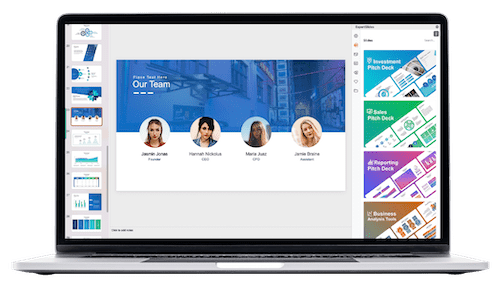Presentation Application Definition – From Boring to Brilliant
Table of Contents
When delivering presentations, the primary objective is to convey a message or idea to an audience in a clear and effective manner. Unfortunately, many presentations struggle to captivate their intended audience, resulting in a lack of engagement. This is where the importance of transforming an unengaging presentation into a compelling one becomes apparent.
A successful presentation is one that not only grasps the audience’s attention but also sustains it, ultimately leaving a lasting impression. It transcends mere information dissemination, instead, creating a memorable experience for the audience.
Key Takeaways
- Engaging presentations are important for capturing and maintaining audience interest
- Transforming boring presentations into engaging experiences requires creativity and strategic planning
- Visual aids can significantly enhance the impact of a presentation
- Storytelling is a powerful tool for captivating audiences and making presentations memorable
- Incorporating interactive elements can help keep the audience engaged and involved
The Importance of Engaging Presentations

Engaging presentations are crucial for effectively communicating ideas and information. When an audience is engaged, they are more likely to retain the information being presented and are more likely to be persuaded by the message. Engaging presentations also help to build rapport with the audience, as they feel more connected to the presenter and the content being shared.
Additionally, engaging presentations are more memorable, leaving a lasting impression on the audience long after the presentation has ended.
Transforming Boring Presentations into Engaging Experiences
Transforming a boring presentation into an engaging experience requires careful planning and consideration. It involves thinking beyond simply delivering information and instead focusing on creating an experience for the audience. This can be achieved through the use of storytelling, interactive elements, and visual aids, as well as by avoiding common presentation pitfalls that can detract from engagement.
One way to transform a boring presentation is by incorporating storytelling. Storytelling has the power to captivate an audience and make the content being presented more relatable and memorable. By weaving a narrative throughout the presentation, the audience is more likely to stay engaged and emotionally connected to the material.
Additionally, incorporating interactive elements, such as polls, Q&A sessions, or group activities, can help to keep the audience actively involved in the presentation, making it a more dynamic and engaging experience.
Tips for Creating Dynamic and Impactful Presentations
| Metrics | Value |
|---|---|
| Number of Slides | 50 |
| Duration | 1 hour |
| Engagement Level | High |
| Visuals Used | Over 100 |
Creating dynamic and impactful presentations requires careful planning and attention to detail. One tip for creating a dynamic presentation is to know your audience. Understanding the needs and interests of your audience can help you tailor your presentation to better resonate with them.
Additionally, it’s important to keep the content concise and focused, avoiding information overload that can overwhelm and disengage the audience. Another tip for creating impactful presentations is to utilize visual aids effectively. Visual aids, such as slides, videos, or infographics, can help to enhance the message being conveyed and make it more memorable for the audience.
However, it’s important to use visual aids sparingly and purposefully, ensuring that they complement the presentation rather than detract from it.
Utilizing Visual Aids to Enhance Presentation Impact
Visual aids are a powerful tool for enhancing the impact of a presentation. They can help to clarify complex information, make data more digestible, and create a more visually appealing experience for the audience. When utilizing visual aids, it’s important to choose high-quality images and graphics that are relevant to the content being presented.
Additionally, it’s important to keep visual aids simple and uncluttered, avoiding excessive text or distracting animations that can detract from the message. In addition to static visual aids, such as slides or infographics, incorporating dynamic visual elements, such as videos or animations, can also help to enhance the impact of a presentation. These elements can help to bring the content to life and create a more immersive experience for the audience.
However, it’s important to use these dynamic visual aids sparingly and purposefully, ensuring that they enhance rather than overshadow the presentation.
The Role of Storytelling in Captivating Audiences
Storytelling is a powerful tool for captivating audiences and making presentations more engaging. By weaving a narrative throughout a presentation, presenters can create an emotional connection with the audience and make the content more relatable and memorable. When incorporating storytelling into a presentation, it’s important to choose stories that are relevant to the topic being discussed and that resonate with the audience.
Additionally, it’s important to keep the storytelling concise and focused, avoiding tangents that can detract from the overall message. In addition to traditional storytelling techniques, presenters can also incorporate personal anecdotes or case studies to make their presentations more engaging. By sharing real-life examples and experiences, presenters can make the content more tangible and relatable for the audience.
This can help to create a more immersive experience for the audience and make the material more memorable.
Incorporating Interactive Elements for Audience Engagement
Incorporating interactive elements into a presentation can help to keep the audience engaged and actively involved in the material being presented. This can be achieved through various means, such as polls, Q&A sessions, or group activities. By allowing the audience to participate in the presentation, presenters can create a more dynamic and engaging experience that encourages active learning and participation.
One way to incorporate interactive elements into a presentation is by using polling software to gather real-time feedback from the audience. This can help presenters gauge the level of understanding and interest in the material being presented and tailor their presentation accordingly. Additionally, incorporating Q&A sessions or group discussions can help to foster dialogue and engagement among the audience, making the presentation more interactive and participatory.
Overcoming Common Presentation Pitfalls and Captivating Your Audience
There are several common pitfalls that presenters should be mindful of when aiming to captivate their audience. One common pitfall is relying too heavily on slides or visual aids, which can detract from the presenter’s delivery and overshadow the message being conveyed. To overcome this pitfall, presenters should use visual aids sparingly and purposefully, ensuring that they complement rather than overshadow the presentation.
Another common pitfall is delivering a monotonous or uninspired delivery that fails to engage the audience. To overcome this pitfall, presenters should focus on delivering their content with enthusiasm and energy, using vocal variety and body language to captivate the audience. Additionally, presenters should be mindful of their pacing and timing, ensuring that they maintain a steady flow throughout their presentation.
In conclusion, transforming a boring presentation into a brilliant one requires careful planning and consideration. By incorporating storytelling, utilizing visual aids effectively, incorporating interactive elements, and avoiding common presentation pitfalls, presenters can create dynamic and impactful presentations that captivate their audience and leave a lasting impression. With these tips in mind, presenters can elevate their presentations from boring to brilliant and create engaging experiences for their audience.
FAQs
What is a presentation application?
A presentation application is a software program used to create and deliver visual presentations. It allows users to create slideshows, add text, images, and multimedia elements, and present the information in a visually engaging way.
What are some popular presentation applications?
Some popular presentation applications include Microsoft PowerPoint, Apple Keynote, Google Slides, Prezi, and Canva. These applications offer a range of features and tools for creating dynamic and professional-looking presentations.
How can a presentation application transform a boring presentation into a brilliant one?
A presentation application can transform a boring presentation into a brilliant one by offering a variety of design templates, multimedia integration, animation effects, and interactive features. These tools can help presenters create visually appealing and engaging presentations that capture the audience’s attention.
What are some key features of a presentation application?
Key features of a presentation application may include slide templates, text and image editing tools, multimedia integration (such as videos and audio), animation and transition effects, collaboration and sharing options, and the ability to present remotely or in-person.
How can a presentation application benefit businesses and professionals?
Presentation applications can benefit businesses and professionals by helping them create compelling and persuasive presentations for sales pitches, training sessions, client meetings, and conferences. These applications can also streamline the design process and enhance the overall professionalism of the presentation.
Get 15+ Mio. PowerPoint Assets - FREE SIGN-UP

Sign up for free to our PowerPoint extension, ExpertSlides. Everything you need, directly in PowerPoint. No credit card required.
Related Posts
Recent Posts
- How Do You End a Presentation – Mastering the Last Impression
- Good Color Combinations for Presentations – The Science of Color
- Interesting Ideas for PowerPoint Presentation – Captivate Your Audience
- History Presentation Template – Step Back in Time
- Canvas Presentation Template – Unleash Your Creativity
Main Menu
Knowledge base
Useful Links






